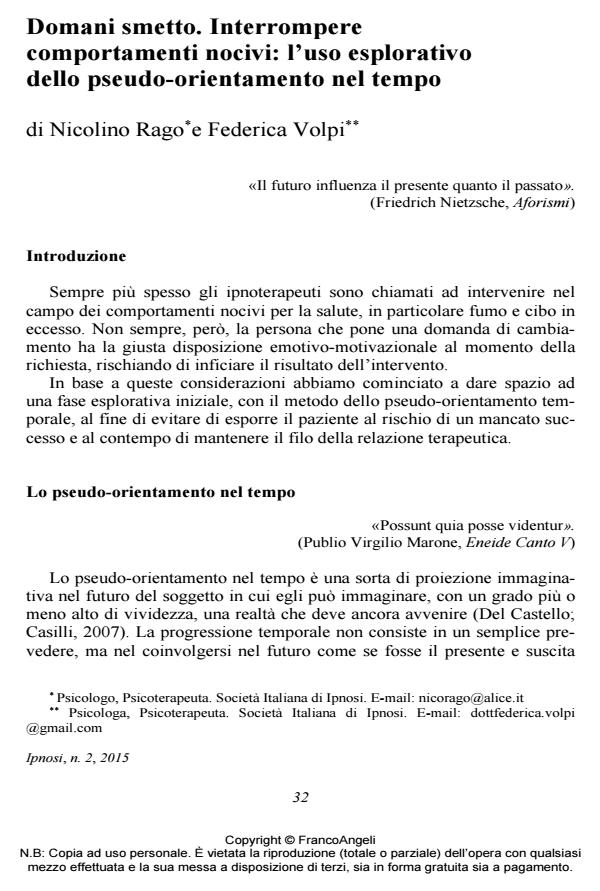Domani smetto. Interrompere comportamenti nocivi: l’uso esplorativo dello pseudo-orientamento nel tempo
Journal title IPNOSI
Author/s Nicolino Rago, Federica Volpi
Publishing Year 2015 Issue 2015/2
Language Italian Pages 16 P. 32-47 File size 74 KB
DOI 10.3280/IPN2015-002002
DOI is like a bar code for intellectual property: to have more infomation
click here
Below, you can see the article first page
If you want to buy this article in PDF format, you can do it, following the instructions to buy download credits

FrancoAngeli is member of Publishers International Linking Association, Inc (PILA), a not-for-profit association which run the CrossRef service enabling links to and from online scholarly content.
Tomorrow I stop it. Interrupting harmful behaviors: the exploratory use of pseudo-orientation in time. In recent years the pseudo-orientation in time has been mainly used as a therapeutic intervention (for example, arousing images and pleasant scenes in depressed patients) or with the evaluation function of the estate of an intervention. The authors want to reconsider the importance of the exploration of the pseudo-orientation in time, recovering the function of insight, that Erickson had already experienced in the 40’s. The method of the "Bridge of the Future", which it will be presented, seems to increase the success’s predictability of an hypnotic intervention. According to the authors, giving more importance to an initial exploratory phase protects the patient from the consequences of a failure for exposing himself at change interventions too early compared to his emotional-motivational disposition at the time of the request. It also allows the patient to discover the blocker factors, to be helped to accept the valid reasons and/or to engage him in a elaboration process of the emotions resulting from the change, even before working for change.
In anni recenti lo pseudo-orientamento temporale è stato utilizzato principalmente come intervento terapeutico (per esempio suscitando immagini e scene piacevoli in pazienti depressi) o con funzione di valutazione della tenuta di un intervento. Gli autori vogliono riconsiderare l’importanza dell’uso esplorativo dello pseudo-orientamento temporale, recuperandone la funzione di insight, che Erickson aveva sperimentato già negli anni ’40. Il metodo del "Ponte del Futuro", che verrà presentato, sembra aumentare la predittività di successo di un intervento ipnotico. Secondo gli autori, dare più importanza ad una fase esplorativa iniziale protegge il paziente dalle conseguenze di un insuccesso dovuto all’essersi esposto a interventi di cambiamento troppo precoci rispetto alla disposizione emotivomotivazionale di cui è in possesso al momento della richiesta. Inoltre, permette al paziente di scoprire i fattori bloccanti, di essere aiutato ad accettarne le valide ragioni e/o ad avviare un processo di elaborazione delle emozioni conseguenti al cambiamento, prima ancora di lavorare al cambiamento.
Keywords: Hypnosis, pseudo-orientation in time, smoke, lose weight, insight, immagination
- Crisi di identità e pratiche ipnotiche: miti e caratteristiche della realizzazione di sé Luca Bidogia, in IPNOSI 2/2023 pp.37
DOI: 10.3280/IPN2022-002003
Nicolino Rago, Federica Volpi, Domani smetto. Interrompere comportamenti nocivi: l’uso esplorativo dello pseudo-orientamento nel tempo in "IPNOSI" 2/2015, pp 32-47, DOI: 10.3280/IPN2015-002002